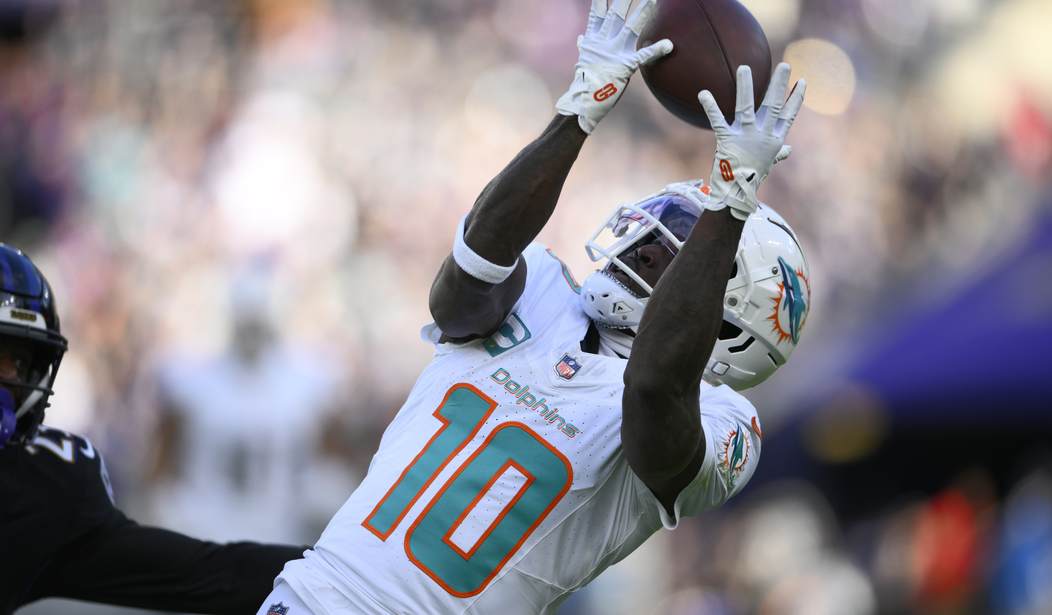I confess I pay little attention to professional sports and had never heard of Miami Dolphins wide receiver Tyreek Hill until yesterday, at which time there was no escaping hearing about him. Bystander video of his Sunday morning encounter with police officers were everywhere to be seen on social media, with the police coming in for much criticism. I reserved judgment, assuming there would be body camera video that would shed light on how the encounter began and what led to Hill being handcuffed.
And now that I’ve seen that body camera footage, I think it’s fair to say the incident was not the Miami-Dade Police Department’s finest hour. Nor was it Tyreek Hill’s, who, in speeding in his $300,000 sports car, brought himself to the attention of the police and was something of a jerk after being stopped.
There are many edited versions of the body camera videos to be found on the internet, but the most complete one I’ve come across is this one, posted by Dallas ABC affiliate WFAA. It has what appears to be unedited footage from all the involved officers, though for some reason it was pieced together non-chronologically. To understand how the incident evolved, one has to begin at the 1:15:06 mark, where we see two Miami-Dade motorcycle officers stopped facing east in the center median of NW 199th Street near Hard Rock Stadium. The camera is worn by the man I’ll call Officer 1, who is parked with Officer 2 in the shade of a pedestrian overpass.
There is no sound in the video at this point, but these officers appear to be in casual conversation when something to the east attracts their attention, something we may safely assume to be, given what we now know to have happened, the sound of a speeding car approaching. Officer 1 puts on his helmet as Officer 2 looks eastward. At the 1:15:38 mark in the video, Hill’s black McLaren can be seen heading west at a speed that appears to be higher than that of the other passing cars. Officer 1 makes a U-Turn and begins to follow.
At the 1:16:07 mark on the video, Officer 1 pulls alongside the McLaren and activates his body-worn camera, which now captures audio. (Axon body-worn cameras like those used by the Miami-Dade police have a buffer that captures video without sound for one minute prior to activation.) The McLaren’s driver’s side window is down as the officer is heard saying, presumably in response to a question from Hill, “Because you were speeding.”
Officer 1 tells Hill to pull forward, then follows him for a short distance before chirping his siren. Hill stops, and we can see his window is still down. As Officer 1 approaches the car, Hill rolls up his window, which is heavily tinted. Officer 1 is now presented with a red flag: a traffic violator whose movements inside the car cannot be seen. For the officer’s perspective, consider this: A fact little known to the general public but well known to those in law enforcement is that attacks on police officers have increased alarmingly in recent years. According to the National Fraternal Order of Police, 2023 saw the highest number of officers shot since the data began being collected. A Google search using the phrase “officer shot during traffic stop” yielded more than 39 million results.
Officer 1 approaches and knocks twice on Hill’s window. Hill lowers the window and says, “Hey, don’t knock on my window like that.” So, yes, it was Hill who first steered the encounter in the wrong direction. The officer had every right to knock on the window, and the video clearly shows he did not “beat on it like he crazy” as Hill would soon claim. Officer 1 asks Hill why he isn’t wearing his seatbelt, to which Hill repeats, “Don’t knock on my window like that.”
After handing over his driver’s license, Hill once again raises the window, to which the Officer 1 reasonably objects. Officer 1 knocks on the window again and tells Hill, “Keep your window down.” Hill lowers the window a few inches and says, “Don’t tell me what to do.”
As a matter of law, Officer 1 was well within his authority to tell Hill to keep his window down. In 1977, the U.S. Supreme Court ruled, in Pennsylvania v. Mimms, that police officers could, to protect their safety, order occupants of a stopped car to exit. Given his inability to see Hill through the tinted window, Officer 1 told Hill to get out of the car. It was here that things began to go very much awry.
We can see that Officers 3 and 4 have now arrived, and when Hill delays his exit from the car, Officer 3 says he will “break that f***ing window.” The same officer then opens Hill’s door and, even as it appears Hill will exit on his own, he grabs Hill, pulls him from the car, forces him to the ground, and then loudly lectures him. “When we tell you to do something, you do it,” he says. “Not when you want, but when we tell you. You’re a little f***ing confused.”
Officer 2 handcuffs Hill and helps him to his feet. While being led to the curb, Hill says to a teammate in a passing car that the police were “beating on my window like they crazy.” Officer 2 tells Hill to sit down on the curb, and when Hill objects that he “just had surgery on [his] knee,” Officer 3 comes behind Hill, grabs him around the chest, and forces him to sit.
One of Hill’s teammates stops his Rolls Royce SUV in front of Hill’s car and gets out. He is quickly challenged and berated by Officer 3. When Officer 3 walks away, Officer 4 very calmly tells the teammate he needs to move his car. For reasons I cannot explain, Officer 1, who should have been writing Hill a speeding ticket, inserts himself into this secondary drama when Officer 4 appeared to have it under control. Officer 1 tells the man to leave, which he agreed to do, only to have Officer 1 change his mind. “Give me your license,” says Officer 1. “You’re getting a ticket too.”
A second teammate, this one driving a Tesla, stops behind the assembled police motorcycles, and despite acting calmly and respectfully with the officers, he too ends up in handcuffs. Within minutes many others arrive at the scene, including a police sergeant and captain, both of whom appear to be aware of what a controversy the incident will soon become. Also arriving were a number of honchos from the Dolphins, including Drew Brooks, the team’s head of security and a retired police officer from Pembroke Pines, Fla., to whom it fell the task of trying to smooth things over.
In due course Hill was given his speeding ticket and released. His two teammates were also cited, unwisely, in my opinion, as both of them behaved like gentlemen throughout the incident. The same cannot be said of Hill, nor can it be said of three of the police officers, one of whom has been placed on administrative leave.
It was simply a pathetic, embarrassing spectacle for all concerned. They should all feel ashamed, but probably don’t.










Join the conversation as a VIP Member